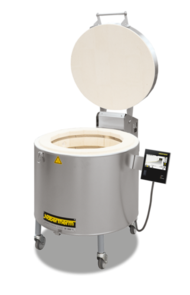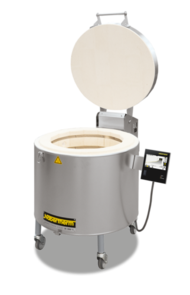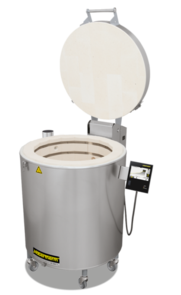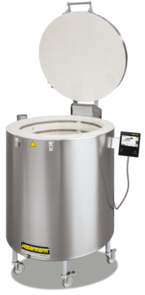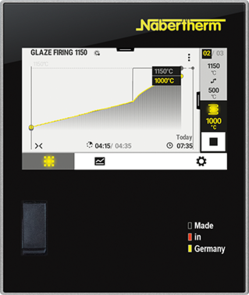During the firing process, time, temperature and kiln atmosphere can influence the maturing of pyrometric cones, the same as any ceramic body.
Heating Rate
Heating rate will greatly affect the temperature at which a cone starts to deform, the rate of bending, and the end point (cone equivalent temperature) of the cone. Typically, the faster the product or cone is heated, the higher the temperature required to mature the product or bend the cone by the same amount. This relationship can be seen in the cone temperature equivalent tables in the Cone Reference Chart. Note that the temperature for the end point of cones increases as the heating rate increases.
Determining the Effective Heating Rate
The maturing of most ceramics occurs during the last 100°C of the firing process. This is also true for the bending behavior of a pyrometric cone. Since cones are time-temperature (heat work) indicators, then the heating rate will affect the end point (when the tip reaches a 90° angle) of the cone. Since most firing profiles incorporate a hold time, the actual or effective heating rate must account for this variable. As a rule of thumb, one can calculate the effective heating rate by determining the total time the ware is subjected to the last 100°C in temperature. As an example, assume that the kiln was heated to a top temperature of 1200°C and it took the kiln 2.5 hours to go from 1100°C to 1200°C. If the kiln was held at 1200°C for 1 hour and then cooled from 1200°C to 1100°C in 0.5 hours, then the total time for the top 100°C would be 4 hours. The effective heating rate is estimated by dividing 100°C by 4 or 25°C per hour. Orton provides temperature conversion tables and charts that allow the bending angle to be converted to an equivalent temperature, if the heating rate is known. This allows for determination of temperature differences within a kiln or a kiln car.
Hold Time
Hold time also affects the bending or deformation of Pyrometric cones. Generally, firing to an equivalent temperature for a cone and then soaking for about 1-2 hours will be sufficient heat work to deform the next higher cone number. Additional soaking of 4-6 hours will deform the following cone, and some 16-20 additional hours will be required to deform the next higher cone in the series.
Kiln Atmosphere
The ceramist knows that kiln atmosphere can have major affect on reactions and the properties of his ware. Since cone deformation is brought about by thermochemical reactions, they can be expected to be affected by the atmosphere in which they are used. Fortunately, the conditions that influence product properties generally have related effects on cone behavior, so that the relative behavior of cones does not change and they are still a useful tool for evaluating temperature distributions within the firing zone of a kiln. The environmental conditions in a kiln most likely to influence cone behavior are:
- Degree of oxidation or reduction
- Presence of sulfur gases
- Presence of water vapor
- Flame impingement on the cones
- Radiation effects involving hotter or cooler surfaces nearby
- Drafts (cool air) in the kiln
Reducing atmospheres can have an adverse effect on the deformation behavior of cones. The low temperature cones, containing glass frit with metal compounds, are especially sensitive to reducing conditions. Also, under reducing conditions, the organic binder cannot be fully oxidized and as a result, these cones may bloat and turn black (see Trouble Shooting section for descriptions of cone problems). Bloating will alter cone deformation characteristics. The "red cones (those containing iron oxide-cones O10 to 3) are also adversely influenced by reducing conditions and will have a green to black appearance after firing.
All cones that do not contain lead or iron oxide (cones O19 through O11, "Iron Free O10 through 3, and cones 4 through 42) can be used satisfactorily in reducing atmospheres provided the organic materials normally present in cones are fully oxidized (burned off) before resorting to a reducing atmosphere. Heating cones to 800-850°F in air will burn off the organic binders. PCE Cones or cones which are pre-calcined have been successfully employed where the entire firing is under neutral or reducing atmospheres.
Cones and most ceramics will generally mature sooner, or at a lower temperature, when fired in a reducing atmosphere as compared with oxidizing conditions. Pre-calcining cones may alter deformation characteristics if they are heated into a region where glass begins to form, so users requiring such treatment should establish their own procedures and controls through testing.
The practice of "flashing a kiln (alternate oxidizing and reducing atmospheres) does not normally have an adverse effect on cone deformation.
Kiln atmospheres which are either sulphurous or reducing may cause some cones to develop a rigid "shell with an interior that becomes fluid, therefore, producing erratic deformation. This shell occurs due to a change in the chemical composition of the cone surface.
Improved Iron-Free Cones, O4 through 3 (available since 1976) and all cones hotter than cone 3 may be used satisfactorily in a sulphurous atmosphere.
"Hard shelling may also be encountered with regular cones O10 through O3 in a high velocity or prolonged firing in a combustion atmosphere. This type of "hard shelling is caused by volatilization of boric oxide from one of the raw materials, glass frit, in the presence of high moisture air. "Hard shelling causes cones to deform at higher than normal temperatures. Severely "hard shelled cones do not bend in an arc but fall over stiffly like a fallen tree. They have a dry matte surface and sharp edges.
The improved Iron-Free Cones, O10 through 3 (available since 1976) are free of boric oxide containing frit and thus do not "hard shell from this cause.
The presence of water vapor, particularly in large quantities, will also influence cone behavior. In fact, even in small amounts, it can cause a cone to deform sooner than normal. The reason for this is that water vapor diffuses into ceramic materials during firing and causes changes in the vitrification process¹. This is the main reason that cones exhibit a different behavior in electric and non-muffled gas kilns. Even though water vapor in the products of combustion can run as high as 19%, it does not necessarily detract from the usefulness of cones because comparable behavior usually occurs in the properties of the ware.
Other Firing Conditions
Fly ash from solid fuel may settle on the cone and to some extent influence its deformation. Likewise, volatile products such as salt fumes, lead, and zinc compounds may produce a surface glaze on the cone, which may or may not influence behavior. The cutting action of flames can cause cones to develop melted tips or behave in other cause abnormal ways. If possible, cones should be protected from flame impingement and kiln drafts.
Radiation from hotter surfaces, or, if the cones are placed close to cooler surfaces, may also affect cone deformation, and, so far as is practical, cones should be protected from this condition as should the ware.













